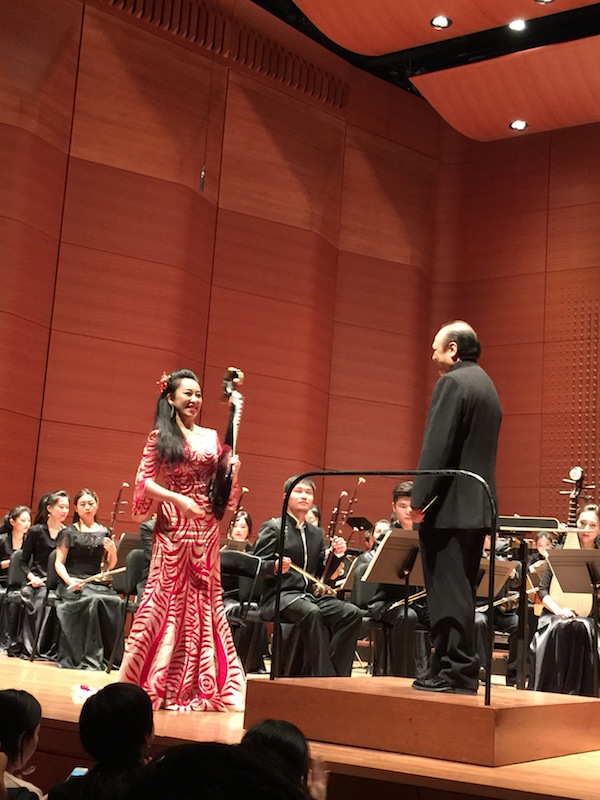Chinese orchestra shows both solo virtuosity and a familiar sense of tradition

Pipa player Zhao Cong takes a bow with conductor He Jianguo and the China National Traditional Orchestra Friday night at Lincoln Center.
Chinese classical music is far older than its Western counterpart but far less recognized beyond its country of origin. The organizers of the annual Princeton International Chinese Music Festival hope to close that knowledge gap, and with a symphonic concert on Friday at Lincoln Center’s Alice Tully Hall they made some progress toward the goal of acquainting the West with Chinese repertory.
“Splendor of Folk Music,” featuring the Beijing-based China National Traditional Orchestra (CNTO), was the first of two festival concerts — the second takes places on Sunday at Carnegie Hall — and perhaps the greatest surprise of the performance was how familiar the music sounded.
The seven works played on Friday are of recent vintage, composed from the 20th Century onward, but for the most part are modeled on centuries-old folk melodies and enduring musical traditions from China’s provinces. Yet in terms of melody, harmony, structure and instrumental timbre, points in common abounded between Western classical and this particular program.
Listening to these earnest odes to nature and humankind, one guesses that elite, urban, music-educated Chinese society has a similar relationship to the cultural artifacts of its rural past: As in the West, folk melodies and culture are a source of fascination, inspiration and compositional ideas.
One noteworthy difference was purely social: Conductor He Jianguo led encores with extended remarks, in Chinese, to an enthusiastic audience between and even during the music. The orchestra also sang, with some audience members joining in. There was a refreshing air of informality to the proceedings, especially as they concluded, with He and other musicians running a veritable receiving line on the stage afterward to shake hands with assorted guests.
The concert opener, Four Pieces from Guangdong Music, celebrated an autumn festival known for boat races as well as song and dance. The first notes — big, broad pentatonic strokes — were a majesterial summons, and from there the Guangdong suite moved through plaintive soloing by CNTO concertmaster Tang Feng on erhu (two-stringed Chinese fiddle) and on to an upbeat, clamoring finale that bore a strong resemblance to a touchstone of contemporary Western music: The “Hoe-Down” from Aaron Copland’s Rodeo.
Up next, Swan, a concerto for pipa (a stringed and fretted lute), presented more distinctly Chinese instrumental coloring, with a virtuoso performance by the featured lutist, Wu Yuxia.
Described in the program notes as more modern Chinese music, but arranged for traditional instruments, Swan felt like an Eastern variation on film scoring or Boston Pops-style orchestration — straightforward and approachable, especially under the genial, populist-style leadership of conductor He.
But it was an ideal showcase for Wu, who demonstrated total mastery of an instrument from which she drew cascading lines and sitar-like drone passages as well as harmonic pings and percussive taps in gorgeous succession.
Wu, who performs again on Sunday at Carnegie Hall, combined intense melodicism and a composerly feel for the pipa with impressionistic, even experimental flashes. In her brilliance there was proof that not all of China’s virtuosos are leaving home to play for Western orchestras.
There were praiseworthy soloists throughout. Wu Lin, on konghou (Chinese harp), played luminously in an ethereal Eastern modality, with affecting microtonal bends that are a hallmark of Chinese twelve-tone scales. Wang Ciheng, playing dongxiao (bamboo flute), brought both lightness of spirit and fiery abandon to Orchids of Spring. Pipa player Zhao Cong was a veritable fireworks show on Blossom — not as nuanced as her counterpart Wu, but technically stunning.
Two large-scale orchestral pieces, Ode to the Sun and the concert’s finale, Capriccio of the Great Wall, were rich in their coloring and pageantry, but also stayed within a relatively narrow melodic and emotional framework, considering the available breadth and depth of traditional Chinese music.
There was a sameness at times to some of the motifs and big flourishes, and perhaps some of that repetition and limitation reflects the music’s origins — works comissioned for an orchestra that is, to quote the program notes, “directly administered by the Ministry of Culture.”
How important, or required, it is for this music to faithfully reflect the state’s conception of Chinese character is difficult for an outsider to know. China is one-party authoritarian, but liberalizing. Should that trend continue, along with this venture in bridge-building, future editions of this concert series may be even more revelatory and interesting, and feel less like official cultural diplomacy.
The festival concludes 8 p.m. Sunday at Carnegie Hall. carnegiehall.org